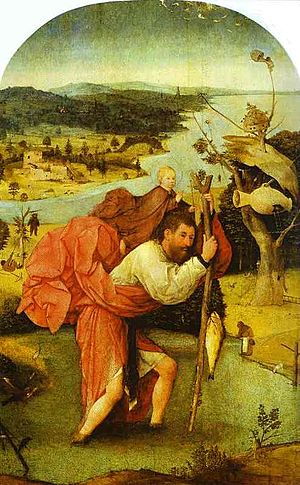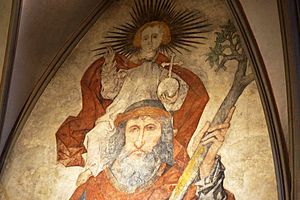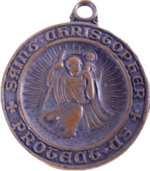Saint Christopher facts for kids
Quick facts for kids SaintChristopher |
|
|---|---|

St. Christopher Carrying the Christ Child, by Hieronymus Bosch (AD 1485)
|
|
| Martyr | |
| Born | Unknown Canaan (Western accounts) or Marmarica (Eastern accounts) |
| Died | 251 Anatolia |
| Venerated in | |
| Canonized | Pre-Congregation |
| Feast |
|
| Attributes | tree, branch, as a giant or ogre, carrying the Christ child, spear, shield, as a dog-headed man |
| Patronage | athletics, bachelors, transportation (drivers, sailors, etc.), traveling (especially for long journeys), surfing, storms, Brunswick, Saint Christopher's Island (Saint Kitts), Island Rab, Vilnius, Havana, epilepsy, gardeners, toothache |
Saint Christopher (Greek: Ἅγιος Χριστόφορος, Hágios Christóphoros) is a special person honored by many Christian groups. He is known as a martyr, someone who died for their faith. He was killed during the time of the Roman emperors Decius (around 249–251 AD) or Maximinus Daia (around 308–313 AD). Churches and monasteries were named after him as early as the 600s.
His most famous story tells how he carried a child across a dangerous river. The child then revealed himself to be Jesus Christ. Because of this story, Saint Christopher is known as the patron saint of travelers. Many Christians wear small images of him or keep them in their cars for protection on journeys.
Contents
Is Saint Christopher a Real Person?
Historians have found evidence that Saint Christopher was a real person. One important piece of evidence is a stone inscription found in 1877. This stone was discovered in the ruins of an old church in Chalcedon, a city in ancient Anatolia.
The inscription on the stone tells us about the building of a church. This church was dedicated to "Saint Christopher’s Martyrdom." It also gives dates for when the church was started and finished. This shows that a church for Saint Christopher was built around the time of the Council of Chalcedon in the 400s AD.
This inscription proves that people honored Saint Christopher in the 400s. It suggests he was a real person who died for his faith. This likely happened during a time of great persecution against Christians in the 300s. Later, around 553 AD, a bishop even took the name Christopher. Also, a nunnery (a place where nuns live) was dedicated to him around 600 AD.
The Famous Legend of Saint Christopher
Stories about Saint Christopher's life and death first appeared in Greece in the 500s. These stories became very popular in Europe. The most famous version comes from a book called Golden Legend, written in the 1200s.
Reprobus, the Giant
According to the legend, Christopher was first called Reprobus. He was a giant from Canaan, about 7.5 feet tall, with a scary face. Reprobus wanted to serve only the "greatest king there was." He found a king who was said to be the greatest. However, Reprobus noticed the king made the sign of the cross when the devil was mentioned. This showed him the king feared the devil.
So, Reprobus left that king to find the devil. He met a group of robbers, and one of them claimed to be the devil. Reprobus decided to serve him. But then he saw his new master avoid a cross by the road. He learned that the devil feared Jesus Christ. So, Reprobus left the devil and began looking for Christ.
Serving Christ by the River
Reprobus met a hermit (a holy person living alone) who taught him about the Christian faith. Reprobus asked how he could serve Christ. The hermit suggested praying and fasting, but Reprobus said he couldn't do those things.
The hermit then had another idea. Because Reprobus was so big and strong, he could help people cross a dangerous river. Many people were drowning trying to get across. The hermit promised that helping people this way would please Christ.
Carrying the Christ Child
Reprobus helped travelers cross the river for some time. One day, a small child asked him for a ride across. As Reprobus carried the child, the river grew rough. The child became incredibly heavy, like lead. Reprobus struggled greatly and barely made it to the other side.
When they reached the bank, Reprobus said to the child, "You put me in the greatest danger! I don't think the whole world could have been as heavy as you were!" The child replied, "You had on your shoulders not only the whole world, but also the One who made it. I am Christ your king, whom you are serving by this work." After saying this, the child disappeared.
This is how Reprobus got his new name, Christopher. In Greek, Christophoros means "Christ bearer."
Martyrdom of Saint Christopher
Later, Christopher traveled to Lycia. There, he comforted Christians who were being killed for their faith. He was brought before the local king and refused to worship pagan gods. The king tried to bribe him with money and sent two beautiful women to tempt him. But Christopher converted the women to Christianity, just as he had converted thousands of others in the city.
The king then ordered Christopher to be killed. Several attempts to kill him failed. Finally, Christopher was beheaded.
Honoring Saint Christopher
Feast Days
Different Christian churches celebrate Saint Christopher on different days:
- The Eastern Orthodox Church honors Christopher of Lycea on May 9.
- The Roman Catholic Church remembers him on July 25.
Relics and Medals
A church in Rab, Croatia, claims to have the skull of Saint Christopher. It is kept in a special gold container. People believe that in 1075, a bishop showed these relics from the city wall. This helped to end a siege of the city by an army.
Many people wear small medals with Saint Christopher's name and picture. These are often worn as pendants, especially by travelers. They show devotion and ask for his blessing. Small statues of him are also often placed in cars. In French, a common saying for these medals is "Look at St Christopher and go on reassured." In Spanish, it's "If you trust St. Christopher, you won't die in an accident."
Who Does Saint Christopher Protect?
Saint Christopher is a very popular saint. He is especially honored by:
- Athletes
- Sailors and boatmen
- Drivers and travelers
- People who go on long journeys
- Surfers
- Gardeners
He is also considered one of the Fourteen Holy Helpers, a group of saints believed to help with various needs. He is asked for protection against lightning, storms, and even toothaches.
Places Named After Him
Many places around the world are named after Saint Christopher. These include:
- Saint Christopher Island, which is the official name for the Caribbean island of Saint Kitts.
- Rab in Croatia.
- Vilnius in Lithuania.
- Havana in Cuba.
- Many towns in France (like Saint-Christophe) and in Spanish-speaking countries (like San Cristóbal).
Saint Christopher in Art
Because Saint Christopher protects travelers and helps against sudden death, many churches have pictures or statues of him. These are often placed where they can be easily seen, like near a church door. He is usually shown as a giant, carrying a child on his shoulder and holding a staff. In England, there are more old wall paintings of Saint Christopher than almost any other saint.
Dog-Headed Depictions
In some Eastern Orthodox Church icons, Saint Christopher is shown with the head of a dog. This might sound strange! These images might be connected to old Egyptian gods like Anubis, who had a dog's head. However, the Orthodox Church generally does not support showing him with a dog's head anymore.
The idea of a dog-headed Christopher might come from old stories. One story tells of a man named Reprobus who was captured by Roman soldiers. He was described as being huge, with a dog's head instead of a human one. This was thought to be typical of a certain tribe. Another idea is that the Latin word for "Canaanite" (Cananeus) was misread as "canine" (caninus), meaning "dog-like." Ancient Roman writers also wrote about "dog-headed men" in parts of Africa.
Some medieval Irish stories even described Christopher as one of the "Dog-heads," a race of people with dog heads who ate human flesh. These stories show how people in the past believed in many different kinds of races.
Saint Christopher's "Giant Tooth"
In the Middle Ages, a church in Vercelli, Italy, claimed to have a very large tooth of Saint Christopher. People traveled from all over Europe to see this special relic. However, in the late 1700s, a scientist looked at the tooth. He discovered it was actually a tooth from a hippopotamus! Since then, the tooth has been removed from the altar and is no longer honored.
Paintings of Saint Christopher
-
The earliest dated woodcut in Europe, 1423, from Buxheim. It shows Saint Christopher with hand-coloring.
-
Saint Christopher, around 1460–70, based on a lost painting by Jan van Eyck.
-
Saint Christopher by Hans Memling, around 1480.
-
Saints Christopher, Jerome and Louis of Toulouse by Giovanni Bellini, 1513.
-
Saint Christopher, Saint Sebastian, Saint Roch by Bernardo Strozzi, early 1600s.
See also
 In Spanish: Cristóbal de Licia para niños
In Spanish: Cristóbal de Licia para niños
- Cynocephaly (dog-headed people)
- List of saints
- Statue of Saint Christopher, Charles Bridge









